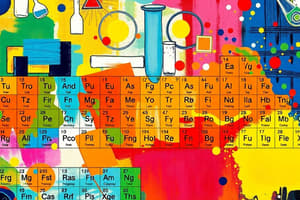Podcast
Questions and Answers
Which block in the periodic table contains elements with one or two electrons in the outermost energy level?
Which block in the periodic table contains elements with one or two electrons in the outermost energy level?
- F-block or deltablock
- P-block or beta-block
- D-block or gammablock
- S-block or alphablock (correct)
Who developed the periodic classification of elements in the 19th century?
Who developed the periodic classification of elements in the 19th century?
- Isaac Newton and Albert Einstein
- Dmitri Mendeleev and Henry Moseley (correct)
- Thomas Edison and Nikola Tesla
- Marie Curie and Niels Bohr
How many groups are there in the modern periodic table?
How many groups are there in the modern periodic table?
- 12
- 18 (correct)
- 6
- 7
What is the modern periodic table arranged in?
What is the modern periodic table arranged in?
How are elements in the periodic table named?
How are elements in the periodic table named?
What is the atomic number based on?
What is the atomic number based on?
Which block of elements consists of transition metals with seven electrons in their outer energy level?
Which block of elements consists of transition metals with seven electrons in their outer energy level?
Where are the lanthanides and actinides placed on the periodic table?
Where are the lanthanides and actinides placed on the periodic table?
Flashcards are hidden until you start studying
Study Notes
Periodic Classification of Elements
Introduction
The Periodic Classification of Elements is a systematic organization of the elements in the universe, based on their physical and chemical properties. It was developed in the 19th century by Dmitri Mendeleev and Henry Moseley, and has since been refined and expanded to include all known elements, as well as a few theoretical ones. The modern periodic table is a comprehensive, interactive table of the elements, which is used as a powerful tool for organizing, analyzing, and predicting the properties of elements.
Modern Periodic Table
The modern periodic table is the most widely used version of the periodic table, with its first edition published in 1879. The table is arranged in rows called periods and columns called groups. Elements in the same group have similar properties and are called congener elements. The table is organized so that elements with similar properties are located in the same group.
Groups and Periods
The modern periodic table consists of 18 groups and 7 periods. The groups are organized into 7 vertical blocks, with each block containing one or more rows of elements. The first block, called the s-block or alphablock, contains elements with one or two electrons in the outermost energy level. The second block, the p-block or beta-block, contains elements with one to six electrons, arranged in pairs of electrons in the outermost energy level.
The d-block or gamma-block is a horizontal strip of transition metals, with five electrons in their outer energy level. The f-block or delta-block is another horizontal strip of transition metals, with seven electrons in their outer energy level. The lanthanides and actinides are the last blocks of elements on the periodic table. These two blocks consist of 14 and 15 elements, respectively, and are placed below the other groups in the periodic table.
Element Naming
Elements in the periodic table are named based on their atomic number, which represents the number of protons in their nucleus. The first element, hydrogen, is named for the Greek word "hydro" meaning water, and the second element, helium, is named for the Greek word "helios" meaning sun. The remaining elements on the periodic table are named using Latin, Greek, or other language roots to represent their properties.
Conclusion
The periodic classification of elements has been a fundamental tool for understanding the properties and behavior of elements, and has played a key role in the development of modern chemistry. The modern periodic table, with its arrangement of elements into groups and periods, provides a powerful framework for organizing and analyzing the elements, and continues to be an essential resource for scientists and researchers.
Studying That Suits You
Use AI to generate personalized quizzes and flashcards to suit your learning preferences.




